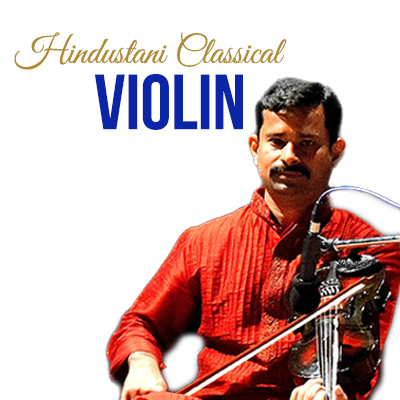
Vision: To appreciate our culture and develop skills of Indian classical music among the students.
Mission: The mission of this course is to enrich quality of life through Music. The course covers many aspects of classical music including performance which can help in developing creative instincts and the development of personality is eventually brought about. The course provides opportunities for the students to grow intellectually.
Objectives:
- To provide a vent for a student to explore his hidden talent after a hectic schedule of core studies and laboratory work.
- To develop the concentration of student through the musical training.
- To inculcate the knowledge of Musical Terms, Biographies, Practical Knowledge of Ragas, Talas, etc.
- To gain the knowledge and grow expertise in writing “notations” for different compositions in various Ragas of the classical music.
- To enhance the knowledge of Laya and Tala and to acquire expertise in presentation of different Bandishes of given Ragas of Indian tradition.
- To provide the students with a thorough theoretical knowledge of some Specific Ragas.
Students who have joined IIT Guwahati for any degree except B.Tech/ B.Des First year can enroll for violin course (basic aptitude test may be necessary for direct entry to Level II onward course).
Course Description:The proposed syllabus consists of 4 numbers of course-modules extending upto 4 semesters (Two years). Each module has been designed in such a way that any module prior to a particular module is the pre-requisite for the latter.
After each semester a skill test will be taken and after successful completion of each year course a certificate will be provided to the registered student. Minimum 70% attendance per semester is required for the course.
Time of class: Two days per week (4:30 pm to 7:30 pm) during working days.Classes will be of one hour duration for each batch.
SYLLABUSModule I (Semester I)
Course code: V- 01: Fundamentals of Indian Classical Music- I & Basics of Violin
Theory:
- Brief history of the Hindustani Classical Music
- Detailed description of violin and its parts
- Technique of holding (importance of left and right hands with their use on violin), playing and producing different swaras/notes on violin
- Short definition of the following technical terms:
- Notation system of Indian Classical Music
Nad, shruti, swara, saptak,sargam, alankar, suddha-vikrita-komal-teevraswaras, thaat, aroh, avaroh, pakad, sthayee, antara, laya, matra, sam, khali, vadi, samvadi,
Detail study of following Ragas with one composition in each:
- Bhoopali
- Bilawal
- Yaman
Knowledge of following talas:
- Teentaal
- Keherwa
- Dadara
Course code: V-02: Fundamentals of Indian Classical Music - II
Theory:
Short definition of the following musical terms
Thata, jati, aroh, avaroh, pakad, sthayee, antara, Alaap, meend, Kanswara, Ashraya raga, vakra-swara, Distinction between thaat and raag,
Notation of prescribed ragas
PracticalDetail study of following Ragas with one composition in each:
- Khamaj,
- Des
- Bhairavi
- Kafi
- Vrindavani Sarang
- Bhairav
Playing some Patriotic songs, Raag based song, and Bhupendrasangeet on Violin.
Knowledge of following talas:
- Jhaptal,
- Rupak
- Ektal
- Chautaal
Course code: V-03: Creativity in Raag & Famous musicians
Theory:
Biographies of famous Indian Musicians
Tansen, PanditVishnunarayanBhatkhande, Pandit Vishnu DigambarPaluskar,Mahapurush ,UstadAlauddin Khan, Pandit Ravi Shanker, Pandit V.G. Jog, Dr. N. Rajam
Making of Taan ,Tihai and Alaap
Thirty two Thaats in Hindusthani Sangeet
PracticalDetail study and performance of following Ragas with one composition in each:
- Bihag
- Bageshri,
- Asawari
- Malkauns
- Bhimpalasi
Study of the following talas:
Teevra, Sulphank, adachautal, jhoomra,
Module IV (Semester IV)Course code: V-04: Performance of a Raag &Theoretical Aspects of Hindustani
Theory:
Salient features of Hindustani system of music:
- The time theory of ragas
- Importance of vadi note,
- Rag Ragini System
- Purvangavadi raga and Uttrangvadi raga
- Sandhi Prakash ragas, Suddha, Chayalag and Sankeerna ragas
- Graha, Ansha and Nyasa swaras.
Detail study of following Ragas with one composition in each:
- Jounpuri
- Kedar
- Puriya Dhanashri
- TilakKamod
- Vibhaas
Study of the following talas:
Dhamar, Deepchandi, Chaachar and all the Taalas learned in previous semester
References :Singh Thakur Jaidev, Indian Music ,SRA Calcutta,1995
Bandopadhyay. S. , Musical Instruments in India, Choukhamba Orientalia, Delhi, 1985.
Srivastav Harishchand, Raag Parichay-Part–1,2&3,Sangeet Sadan Prakashan, 2013
Jauhri Shruti, Elements of Hindustani Classical Music, D.K.Printworld, 2011
Bagchee, Sandeep, Naad-Understanding Raga Music, Eeshwar Delhi, 1998
Garg. Prabhulal , Sangeet Visharad ,Sangeet Karyalay Haathras, 1996
Course Instructor - Dr. Devanand Pathak know More